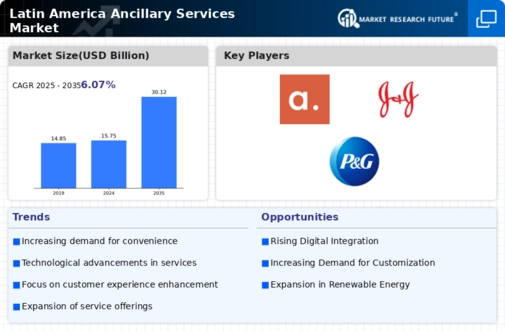Market Analysis
In-depth Analysis of Latin America Ancillary Services Market Industry Landscape
The market dynamics of the Latin America ancillary services sector offer a complex and evolving landscape driven by a combination of factors such as changing consumer behaviors, airline strategies, regulatory frameworks, and economic conditions. Ancillary services encompass a wide range of offerings beyond the core airfare, including baggage fees, seat upgrades, in-flight amenities, travel insurance, and car rental bookings. In recent years, ancillary services have become a crucial revenue stream for airlines, helping them offset operational costs, optimize revenue per passenger, and improve overall profitability. As a result, the Latin America ancillary services market has witnessed significant growth and innovation as airlines seek to diversify their revenue streams and enhance the passenger experience.
One of the primary drivers of the Latin America ancillary services market is the shifting preferences and expectations of air travelers. With increasing competition and price sensitivity in the aviation industry, airlines are under pressure to differentiate their offerings and provide value-added services that meet the evolving needs of passengers. This has led to the proliferation of ancillary products and services aimed at enhancing convenience, comfort, and customization options for travelers. From priority boarding and extra legroom seating to Wi-Fi access and onboard dining upgrades, airlines are continuously expanding their ancillary service offerings to cater to diverse passenger preferences and capture additional revenue opportunities.
Furthermore, airline strategies play a crucial role in shaping the dynamics of the Latin America ancillary services market. Airlines employ various pricing and merchandising tactics to maximize ancillary revenue, such as dynamic pricing algorithms, bundled package deals, and targeted upselling techniques. By analyzing passenger data and booking patterns, airlines can identify opportunities to promote ancillary services at different stages of the travel journey, from the initial booking process to post-purchase interactions. Additionally, partnerships with third-party service providers enable airlines to offer a broader range of ancillary products and leverage external expertise to enhance the value proposition for passengers.
Regulatory frameworks and industry standards also influence the dynamics of the Latin America ancillary services market. Government regulations governing pricing transparency, consumer rights, and aviation safety can impact the availability and pricing of ancillary services offered by airlines. Additionally, industry associations and regulatory bodies may establish guidelines and best practices for ancillary service providers to ensure fair competition and consumer protection. Compliance with these regulations is essential for airlines and ancillary service providers to build trust with passengers and maintain a positive brand reputation in the market.
Economic conditions and market trends further shape the dynamics of the Latin America ancillary services market. Economic growth, exchange rate fluctuations, and changes in consumer spending patterns can impact passenger demand for ancillary services and influence pricing strategies. Moreover, external factors such as geopolitical events, natural disasters, and public health crises can disrupt travel patterns and create volatility in the ancillary services market. Airlines must be agile and responsive to these economic dynamics, adjusting their ancillary offerings and pricing strategies to adapt to changing market conditions and maintain competitiveness






Leave a Comment